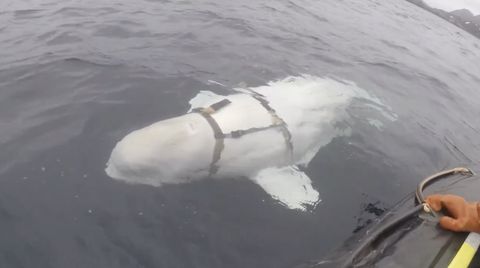A beluga whale approached a Norwegian fishing boat in late April of this year wearing a harness with ‘Equipment of St Petersburg’ written on it. Now, usually being approached by such a creature in its natural habitat would be an experience worthy of going viral on Facebook, however, the dark subtext of military exploitation stirred a global frenzy of questions and conspiracies.
Unconventional means
The harness in question may have been designed for the carriage of a camera or weapons, and it has been proposed that this beluga whale had escaped from the Russian Navy. The idea is that Russia may have been experimenting with whales as military assets. The encounter is a reminder of unconventional thinking and possible threats military forces may face from unexpected means.
While the world has been shocked, the use of sea mammals for military purposes is not a new idea or practice. Since the start of the Cold War the United States has been using sea mammals in a military capacity. Initially they studied hydrodynamic swimming skills of sea mammals for the purposes of developing torpedo and submarine design. They then started using bottlenose dolphins and sea lions as sensors, utilising their deep-sea diving, sonar, underwater vision and hearing abilities.*
The Russian Defence Ministry has denied the existence of a sea mammal program, yet they’ve also openly advertised for and purchased dolphins in the past. In 2000, Iran purchased a number of dolphins, sea lions, seals and walruses from a military sea mammal trainer in Crimea, including a beluga whale.
For Australia, the relationship with sea mammals is one of protection. The Royal Australian Navy is committed to researching the potential effects that active sonar may have on whales and the potential correlation between active sonar and pod beaching.
Thinking differently
The events in Norway are an impetus to think differently about the challenges and threats military forces may face in the maritime environment. Possible challenges could include marine mammals being teamed with clearance divers and birds being used as anti-drone assets.
We need to think differently about these unconventional challenges. To do so, the naval community has been consulting science-fiction writers and video game experts, among other creative thinkers, alongside industry leaders in the development of new capabilities and survivability against emerging threats. Unconventional subject-matter-experts help challenge set ways of thinking.
To combat new and emerging threats, we need to go beyond ‘that’s the way it’s always been done’. Helping to think unconventionally may include incorporating gaming hardware, such as console controllers, into our platforms. It’s worth noting the U.S. already uses Xbox controllers because they don’t require development and are extremely cheap to purchase.
Not every idea is going to be feasible, but creative thinking is an important skillset to think unconventionally about the possible threats military forces may face from unexpected means.
About the Author: Officer Cadet Lucinda Branson is a trainee officer in the Royal Australian Air Force. She is currently studying a Bachelor of Arts majoring in Indonesian and English and Media Studies at the Australian Defence Force Academy. Following graduation, she will undertake pilot training at the Air Academy. Her current favourite novel is ‘The Hunt for Red October’.
*Ethics and animal welfare should be forefront of discussions about animals being used for military means.

